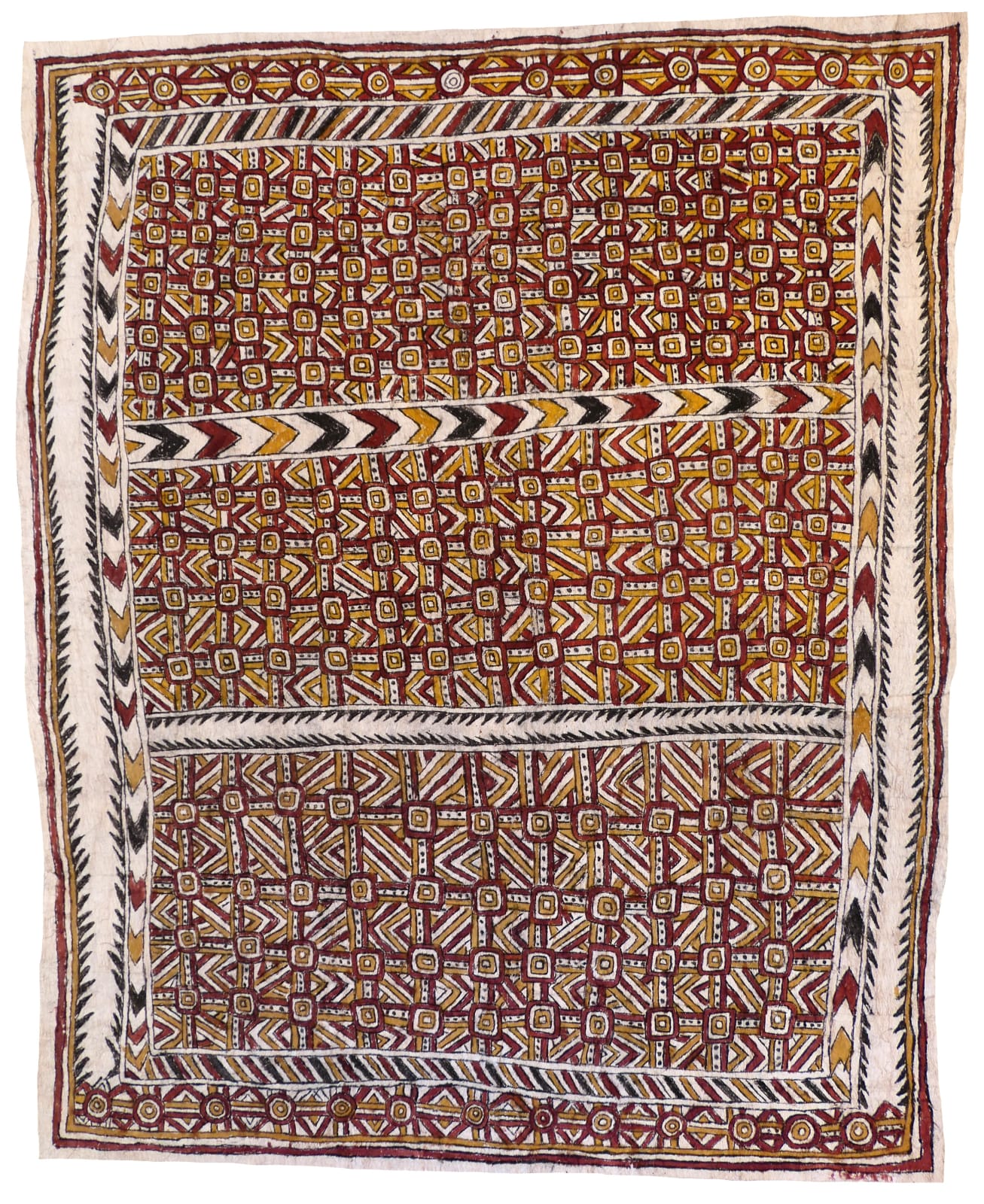Hilda Mekio PNG, Omie- Emate, b. 1978
Hilda Mekio PNG, Omie- Emate, b. 1978
Design of the eye, teeth of the river fish, spots of the wood- boring grub, Ömie mountains,Ujawé initiation design of the navel, and Papuan Hornbill beaks, 2022
natural pigments on nioge (barkcloth)
90.5 x 70.5 cm
22-027
The border and bands are known as orriseegé (paths/pathways) and provide a compositional framework for the design. The or'e (path) designs are ancient and originate from the time of the...
The border and bands are known as orriseegé (paths/pathways) and provide a compositional framework for the design. The or'e (path) designs are ancient and originate from the time of the Ancestors and relate to the intricate footpaths that run through food gardens and garden plots.
The concentric square motif is nuni'e, the design of the eye. The nuni'e design can also be found woven on armlets and waistbelts which are made from numise (yellow orchid fibre), jukire (black orchid fibre) and ninube (brown orchid fibre). Between the nuni'e designs, are a combination of two designs - dahoru'e, the design of the Ömie mountains, which references the sacred ancestral geography of Ömie territory; and visuanö'e, the teeth of the river fish.
The spots are a design called sabu ahe representing the spots which can be seen on the sides of a wood-boring grub. This grub is sacred to Ömie people as it plays an important part within the creation story of how Huvaimo (Mount Lamington) came to be volcanic. It is a traditional sor? (tattoo design) which was most commonly tattooed running in one line under both eyes.
The arrow/chevron motifis bubori anö'e, the beaks of the Papuan Hornbill. Hornbills are the largest flying birds that can be found in the Ömie mountains. In the ancient story of how the first group of people emerged onto the surface of the earth from Awai'i underground cave at a site known as Vavago, one man [who cannot be named due to current Ömie jagor'e (law)], used his hornbill beak forehead adornment as a tool to chisel his way through the rock and into the light of the world.
The conjoined, concentric circles seen within the upper and lower bands of orriseegé are, vinohu'e, a design whcih was tattooed around men's navels during the Ujatvé initiation rite. Vinohu'e literally translates to 'design of the navel'. This design is related to the Siha'e design, which represents the fruit of the Sih'e tree. Sihe is a yellow fruit found in the rainforest and often eaten by cassowaries. In the time of the Ancestors during times of tribal warfare, the Ömie male warriors had no food while they were defending their borders in the forest far from their villages so they survived by chewing the sihe fruit, swallowing the juice and then they would spit out the pulp.
The concentric square motif is nuni'e, the design of the eye. The nuni'e design can also be found woven on armlets and waistbelts which are made from numise (yellow orchid fibre), jukire (black orchid fibre) and ninube (brown orchid fibre). Between the nuni'e designs, are a combination of two designs - dahoru'e, the design of the Ömie mountains, which references the sacred ancestral geography of Ömie territory; and visuanö'e, the teeth of the river fish.
The spots are a design called sabu ahe representing the spots which can be seen on the sides of a wood-boring grub. This grub is sacred to Ömie people as it plays an important part within the creation story of how Huvaimo (Mount Lamington) came to be volcanic. It is a traditional sor? (tattoo design) which was most commonly tattooed running in one line under both eyes.
The arrow/chevron motifis bubori anö'e, the beaks of the Papuan Hornbill. Hornbills are the largest flying birds that can be found in the Ömie mountains. In the ancient story of how the first group of people emerged onto the surface of the earth from Awai'i underground cave at a site known as Vavago, one man [who cannot be named due to current Ömie jagor'e (law)], used his hornbill beak forehead adornment as a tool to chisel his way through the rock and into the light of the world.
The conjoined, concentric circles seen within the upper and lower bands of orriseegé are, vinohu'e, a design whcih was tattooed around men's navels during the Ujatvé initiation rite. Vinohu'e literally translates to 'design of the navel'. This design is related to the Siha'e design, which represents the fruit of the Sih'e tree. Sihe is a yellow fruit found in the rainforest and often eaten by cassowaries. In the time of the Ancestors during times of tribal warfare, the Ömie male warriors had no food while they were defending their borders in the forest far from their villages so they survived by chewing the sihe fruit, swallowing the juice and then they would spit out the pulp.
